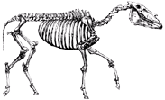![]()
 |
* Click here to learn about the Hagerman paleoecosystem. * VISIT the fossil bone photo archive. * ACCESS Hagerman Fossil Beds GIS data. |
Terms
& Phrases
Hagerman Reference Diagrams
Fossil Range Chart Paleomagnetic Time Scale Glenn's Ferry Stratigraphy Peters & Fossil Gulch Stratigraphy |
Established in 1988
* View
Location Map
* Visit the Monument
Web Site
Introduction
There are many fossil
sites located in Idaho. One of the most important of these is the Hagerman
Fossil Beds National Monument - the location of the "Hagerman Horse"
fossils (Equus simplicidens) - Idaho's state fossil.

Hagerman Horse Bones
Hagerman is located in south-central Idaho on the Snake River. The beautiful
Hagerman Valley was formed from the Bonneville flood, which swept through
the Snake River Canyon approximately 14,500 years ago. Evidence of this flood
can be found on the valley floor in the form of basalt boulders which were
left by the receding flood water.

Melon gravels deposited
by the Bonneville Flood.
For more information visit the Lake Bonneville Flood.
The Fossil Beds are located across the river to the southwest from the town in a series of steep bluffs formed by the Snake River cutting through the Glenns Ferry and Tuana formations. Erosion of the bluffs over time has revealed a spectacular view into Idaho's geologic past.
Click here to learn more.

Sedimentary outcrops.
Elmer Cook, a cattle rancher living in Hagerman, Idaho, discovered some fossil bones on what is now monument land in 1928. He showed them to Dr. H.T. Stearns of the U.S. Geological Survey who then passed them on to Dr. J. W. Gidley at the Smithsonian Institution. Identified as bones belonging to an extinct horse, the area where the fossils were discovered was excavated and three tons of specimens were sent back to the Smithsonian in Washington, D.C.
Of all the fossils uncovered, the most important find was the large volume of a species of extinct horse known as Equus simplicidens, and named the Hagerman horse.

Excavation continued into the early 1930's. The quarry floor grew to 5,000 square feet with a backwall 45 feet high. Ultimately five nearly complete skeletons, more than 100 skulls, and forty-eight lower jaws as well as numerous isolated bones were found. Finding such a large deposit of an animal in one location is a rare occurrence. An early explanation for the deposit was that the quarry area was once a watering hole where the bones of the Hagerman horses accumulated as injured, old, and ill animals, drawn to water, died there. It is now known that an entire herd of these animals probably drowned attempting to ford a flooded river and were swept away in the current. Their bodies were then quickly buried in the soft sand beneath the water.
Click here to learn more about the Hagerman Horse Quarry.
The National Monument was established in 1988 to preserve the important finds. The Oregon Trail crosses the southern portion of Hagerman Fossil Beds. The monument is one of only 3 units in the national park system that contains parts of the Oregon National Historic Trail. In addition, many artifacts have been recovered that indicate the presence of Native Americans in the area.
Geology
Hagerman Fossil
Beds are located on the eastern edge of the Western Snake River Plain. The
general geology of the monument consists mainly of sediments of the Glenns
Ferry and Tuana Formations of the Idaho Group which lie unconformably on siliceous
Idavada volcanics. These sediments inter-bedded with an occasional basalt
flow, silicic volcanic ash and basaltic pyroclastic deposits, range in age
from 2.5 - 3.5 ma and represent deposition within lake, stream and flood plain
environments. These unconsolidated sediments that outcrop at Hagerman have
yielded a remarkable amount of fossils.
For more information on the Geology of the Hagerman Area Click here.